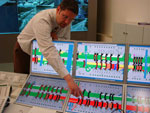
The managed lanes strategies that maximize existing roadway use and help minimize the need for new construction were first deployed in just four places — two in Texas and two in California. A look at the list today reveals 39 projects nationwide that already exist, are under construction or are in development.
More than 816 miles of roads — and millions of commuters — are either already benefiting or soon will benefit from managed lanes research at TTI under the leadership of Senior Research Engineer Beverly Kuhn and Research Engineer Ginger Goodin.
“When we started the managed lanes project at TTI in 2000, there were only four domestic facilities in operation, and hardly any on

the books,” says Kuhn. “Now there’s been an explosion of these facilities. And because of the interest being generated in the subject, a new Managed Lanes Joint Subcommittee was created in 2004 under the Transportation Research Board’s (TRB) HOV Systems Committee to address research needs and issues specific to managed lanes.”
TTI Research Engineer Ginger Goodin was first to chair the joint subcommittee.
Strategies from abroad
After nearly a decade of research and crafting the comprehensive Managed Lanes Handbook, the research team looked overseas for additional strategies and best practices.
With sponsorship from the Federal Highway Administration, American Association of State Highway and Transportation Officials and the National Cooperative Highway Research Program, a group of transportation professionals from around the country, including Kuhn, observed managed lane operations and strategies in Denmark, England, Germany and the Netherlands.
“They’ve taken the next step in managing their facilities,” says Kuhn. “They’re managing the entire facility in an active manner. They implement temporary shoulder use, speed harmonization (variable speed limits) and other strategies. As congestion builds on a facility, those strategies can be implemented to better manage the entire corridor.”
Speed harmonization involves an automated system that uses an algorithm for measuring speeds, congestion and other factors to determine the best speeds to set along a corridor to encourage flow, or throughput. Speeds are adjusted ahead of congestion automatically, and drivers see speed limits for roadway sections displayed on changeable signs above the road.
The team observed a work zone in Copenhagen that benefited from this technique — with no increase in accidents during the work zone, a benefit local agencies tied directly to speed harmonization.
“Strategies like this — called active traffic management — represent the next evolution of managed lanes,” says Kuhn. “And the trip where we saw these deployed got me thinking, ‘Why can’t we do this here?'”
